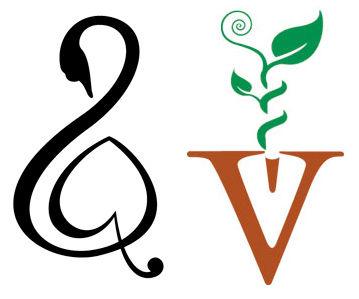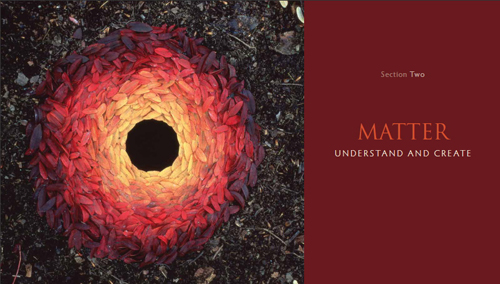Design by Nature: An Interview with Maggie Macnab
Peachpit: In the introduction to your book, Design by Nature: Using Universal Forms and Principles in Design, you say that by recognizing the principles, patterns, and processes of nature, you can create intuitively elegant and aesthetic design at will rather than by chance. Can you give an example from the book of a pattern, principle, or process that will help people become better designers?
Maggie Macnab: One of the most important things to walk away from Design by Nature with is the basic understanding that patterns and shapes in nature express its process as forms that all humans experience through our senses. They are common to everyone. Patterns express energy in physical ways that are understood regardless of where you come from, and universal principles drive their various processes of coming into being. We understand these shapes and patterns intuitively: Words are the language of the head, but visuals carry the intuitive language of the heart. The language of nature is universal and it is our first and primary language. Design by Nature is about recapturing the lost art of reading nature to create better visual communications—as well as give a better understanding (and appreciation) of nature.
Because nature is within and without us, there are examples everywhere. For instance, the spiral is a form that expresses a repetitive motion, but also one that is in a continual and geometrically progressed curve. It follows its prior path as a curve, but it expands ever outward as it goes. This is a very important shape for life! It is the shape of any embryo that evolves from its center outward and unfurls into a living, breathing life form. This is a wonderful shape to use as a template for a logo or graphic for a client involved with creative, progressed or inventive services or products. It is the embodiment of evolution: connected and the same in many ways (alike to the prior generation is an example), but expansive, too (a composite of the parents that introduces variation). The spiral’s form perfectly expresses its function as similar to and different than—it is the ultimate shape of creativity.

Figure 1 Two examples of logos that incorporate the spiral as an underlying template. SwanSongs is a non-profit that helps transition dying people with musical last requests, and Valle Encantado is a community-based non-profit that “cultivates community” with local farm produce and traditional Hispanic crafts. The shape of the spiral supports each organization’s intent by using the metaphor of a spiral as a message of generative creativity. SwanSongs: ©1985 Maggie Macnab, and Valle Encantado: ©2010 Maggie Macnab.
Another obvious but invisibly ubiquitous shape is the square, or four sided shape. Perfectly four sided shapes hardly occur in nature, but the built world has them everywhere. They are necessary to construct with stability and reliable repetitiveness. A square would be the equivalent of the spiral’s opposite. What does a square represent to you? If you’re like 100% of the people who answered this question for cultural anthropologist Angeles Arrien who studies shapes in cross-cultural art, you see stability, solidness—even stagnation. Curves and corners represent very different functions in the world, and they both visually express their individual purposes perfectly. Curves connect and angles define. So, obviously, for clients who deal with specifics—money, let’s say, or any of its associated professional activities: taxes, insurance, the stock market—they absolutely want to convey themselves as reliable, dependable, and stable, with certainty and definition. They oftentimes use a linear, four sided or angular logo to get across the idea of security. Are they necessarily secure and solid? Absolutely not, but humans intuitively read it as such, and it creates a powerful subliminal description that we often take at face value. This book is also about understanding how we respond to the tricks of the trade to make the reader a more conscientious and critical thinker.

Figure 2 The HSBC and NYSE logos display hard edge angles, a typical design element for businesses that want to look precise, stable, secure and materially-oriented.
Peachpit: Can you give an example of a design that people might be familiar with that you think integrates the principles and processes of nature to tell an authentic and useful story?

Figure 3 Bob Dylan Portrait by Milton Glaser, ©1967 Milton Glaser
Maggie: This is a classic poster designed by Milton Glaser in 1967. Dylan fans will know it—as do those of us old enough to have been around when it came out bundled in Bob Dylan’s Greatest Hits (I bought this album at age 14 in the late 60s, already a big fan). This design appears in Chapter 3, “Nature’s Ethics: Everyone’s Business,” I talk about the twelve principles of permaculture design. Permaculture is a system that mimics nature’s patterns and relationships to provide high-yield natural resources (food, fiber, and energy) with low impact on the environment. It was developed by David Holmgren in Australia in the 1970s. How can permaculture principles possibly relate to graphic design, architecture, environmental design—or any other design discipline, for that matter? Because the best design thinking works within the basic principles of nature and is comprised of whole systems thinking; that is, it is concerned with relationships. Good design’s fundamental purpose is to create relationship. Some of the permaculture principles described in the book include relating all the parts, defining edges, observing and interacting with nature, obtaining a yield, maximizing relationships, designing from patterns to details, and resilience. The simplicity of Glaser’s poster is one of its most alluring aspects, but look also at how the details relate to the larger whole. This poster is designed from pattern to detail (Dylan’s simple black and white profile explodes into a riot of colorful locks that follow similar lines); it maximizes edges (definition between edges is apparent); is integrated (though composed of distinct parts it still reads as a cohesive whole); resilient (it has stood the test of time); practices no waste (simplicity); and allows for diversity (bright colors side by side and other elements of contrast). Maybe readers will find other principles, too. It probably covers almost all of them.
Peachpit: What are the most common patterns found in nature that are used frequently by designers in their work? Why are they so effective?
Maggie: There are really only a few basic patterns in nature, because energy only needs a few functions to exist within three dimensional space. The processes of energy include connection, movement and storage...simple stuff. As described in the first answer, the forms can be quite apparent in their function if you just use your powers of observation. Some of the patterns include branching and meanders (which are obvious and all around us); these are patterns of moving energy from one point to another. Stacking and packing patterns hold energy in storage compactly and out of the way—but this pattern also keeps them quite accessible for when they are needed (the hexagons that comprise a bee’s hive demonstrates this pattern, as do the four sided shapes of architectural design). The spiral (discussed earlier), and the helix and weaving patterns are related to energy that connects. Look at our own DNA in the form of a double helix: two opposites are made stronger through the cooperation of entwinement and direct relationship. They work with each other to make a sound and complete whole—us!
Patterns of nature are incredibly powerfully integrated into visual communications because every human on earth comes from a long line of pattern-readers. This is how humanity has survived and thrived to the present day. We observe, we understand, we reinterpret. From that knowledge, we have invented amazing structures, systems and ideologies that have ironically separated us from nature. Design by Nature is about reclaiming what you know and bringing it to the surface so you can work on problems creatively, intentionally and with common sense. These include not only design problems, but also the bigger ones, too, and we have some serious ones to face right now. Creative thinking is the only way we will solve some of the biggest issues at this juncture in human history.
Peachpit: What’s your favorite pattern in nature and why?
Maggie: I’m a spiral lover, and I find this is true of my many of my students, too. We love creativity and exploration! It’s my favorite shape and pattern (something interesting about this form is it is both a shape and a pattern, while the other patterns and shapes are quite specific and separate). But they are all great. What’s not to like about any of them? They each contain a specific purpose, and each is necessary for functionality in the world. Preferences are just inclinations that we all have because we come with personalities.
Peachpit: Why did you decide to become a designer?
Maggie: I love creative thinking and I love applying it to problem solving. Design is the embodiment of both. Design led me to teaching, and teaching led to writing about what I learned as an educator. I understood early on that this is the way nature works, and I wanted to share it as widely as possible. I’m hoping Design by Nature will contribute to the reader’s awareness of how creativity and problem solving are not separate endeavors, but are actually quite complementary and practically paired, and that nature is a perfect mentor for it. I’ve had too many direct experiences with using creativity to produce unique yet widely viable solutions, in both my work and personal life. It’s available to anyone—we all come of nature and intuitively understand much of it—and with some minimal guidance, most get it. I find you just point the student or designer in a direction, give them a little context, and turn them loose! This is what we’re made for. Human beings are immensely inventive and creative—it’s far more powerful than our other hallmark of cleverness. I believe we can solve any problem we need to if we are given the creative rein and resources to do so.
Peachpit: How did you first become interested in nature and how has that informed your design work and teaching?
Maggie: I was fortunate to have parents who were open to experience and not jaded or trapped in social norms. My family was definitely not normal! My father, an architect, poet and artist, acquainted me early on with nature: camping, horseback riding, cooking, exploring; and also with creativity: drawing from nature, looking at invisible worlds through a microscope, reading science fiction and imagining what could be possible. This is how kids should learn, I think, and is how I tried to raise mine. There is much lacking in our educational system...the first clue being that it is overly systematic. Teachers should be mentors, not test-givers. We live in a cultural climate that oversimplifies and directs what we don’t understand. There’s no room for letting students feel their way to a solution. All humans need at least a basic introduction to music, art, poetry and play so they have the creative tools to approach a problem from many directions. Some of the most remarkable inventions have been conceived by integrating intuition into intellectual thought. Like the DNA helix, they are good partners for viable, practical results. Good design is based on this, too. You can’t just use one method for creativity! Learning should be creative, exploratory and loose; this is the environment I try to provide for my students. There needs to be context, of course—results must be accomplished and teaching the basics is important. I just see the basics of nature as a fundamental piece of knowledge every human being should have—and that we did have until relatively recently. This develops the wisdom of truth, rather than a facility with facts. Life isn’t a test—test taking is irrelevant when it comes to dealing with some of the most important problem solving we must address in life. Life requires multiple skills to problem solve effectively. Creative thinking springs from observing nature as well as creating a wholeness of understanding. I had traditional learning like anyone (up through 11th grade), but it was supplemented with what I consider my most important education: being given the opportunity to observe and respect nature’s incredible power and beauty. This isn’t head work, it’s heart work. The heart knows truth, the head knows facts. Truths remain consistent over time while facts vacillate depending on the source and what’s known in the moment. As we’re always learning, they can be highly unreliable.
Peachpit: What inspired you to write this book?
Maggie: I love the beauty and efficiency of nature, and I believe most people—of any culture, speaking any language—want to get to know, learn from, and support one other. We’ve entered the very interesting time of global communications, and what we’re finding is that “different” is far more in our heads than in our hearts. The news says one thing, but those of us out in the social networks: we’re saying another. We have far more in common than not.
From a graphic design perspective, there is far too much noise and repetitiveness in the flood of visual information that assaults us (unfortunately, it is more often an assault than not). There is absolutely no reason visual communications can’t be beautiful, effective and provide some kind of value for the viewer’s time: that is, tell me something I didn’t know. Give me a laugh. Make me of think of something I hadn’t. Connect me with the rest of the world. Teach me.
Peachpit: Please tell us about the Guest Design Study sections in the book. How do they build on the material in the book?
Maggie: The first way we learn is through our eyes. The second way is through our hands. We experience knowledge by integrating it as a physical action. I personally find it very helpful to see diversity of style with creativity and problem solving. The multiple guest designers in Design by Nature show a wide range of different types of creativity and practical problem solving skills. Some will fit for readers; some will not. But I would venture to say they are all fascinating—and at the very least interesting. The reader is then turned loose to try some of the ideas and styles out in the exercises that follow most of the chapters. This is where you can explore different approaches, hopefully discover some new methods, and push some limits. This is where the rubber meets the road and you learn how to put your creativity into gear!
Peachpit: What is the favorite section of your book and why?

Figure 4 ©Andy Goldsworthy
Maggie: Design by Nature has three sections, each comprised of three chapters, and each section opens with a lovely piece of nature art by Scottish artist Andy Goldsworthy. The three sections are Memory: Remembering What We Know; Matter: Understand and Create; and Motion: The Experience Enhanced. It sounds hokey, but I love them all. Each has a different kind of value and each surprised me as I wrote it. The book didn’t exactly write itself, but I asked and the right people stepped up to contribute. I got stuck and found a way to pry myself out of the mud. I obsessed and let go. It was really quite a wonderful process—but, of course, I say this in retrospect. It wasn’t an easy process, but it was clear Design by Nature wanted to be written and the time was right. I was the one there to do it. I’m pretty passionate about my work and about nature, so we made a good fit.
Peachpit: Who inspires you as a designer and does any of their work appear in the book?
Maggie: Oh, my gosh. Well, every one of the contributors inspires me or I wouldn’t have asked. What brilliant work: each different, each lovely, each instructive. Courage and commitment speaks volumes to me, so the street artists were amazing to include and interact with. The international designers, who were so willing to contribute, were terrific, and we occasionally struggled with language barriers, but not for long. The famous designers equally so, even with their overwhelmed schedules and multiple other commitments. The students, not completely assured of their work quite yet—but in blind tests, who would know they were only students? Anyone, anywhere who has the courage to do what they feel is right for them and find their way towards it; these are the people that I admire and feel kinship with from afar. I’ve fumbled my entire life towards what I love, but I’ve never taken my eye off the ball. This is true—I’m sure—of just about everyone in the book. I couldn’t fit them all in, so I guess that leaves room for a sequel!
Peachpit: What do you love most about what you do for a living?
Maggie: That my life is my design: what I learn in life feeds my work and vice versa.
Peachpit: What do you do when you’re not writing or designing?
Maggie: Teaching, gardening, tending chickens, traveling, cooking, hanging with my grown kids when they’re around—and I’m a huge foodie! When I travel, I ingest cultures. I think this is the best way to get to know them!
Peachpit: What’s the most important piece of advice you could give another designer?
Maggie: Do what you love and never do anything but what you love. Commit to the wisdom that is inherently part of your individual package.
Peachpit: What do you see as the underlying purpose of design?
Maggie: Design makes chaos meaningful. When it works well, it makes it beautiful.
Peachpit: What are you working on next that’s exciting to you?
Maggie: I hope to travel the world and work with young designers—all the while sampling the bounty of their region, of course!